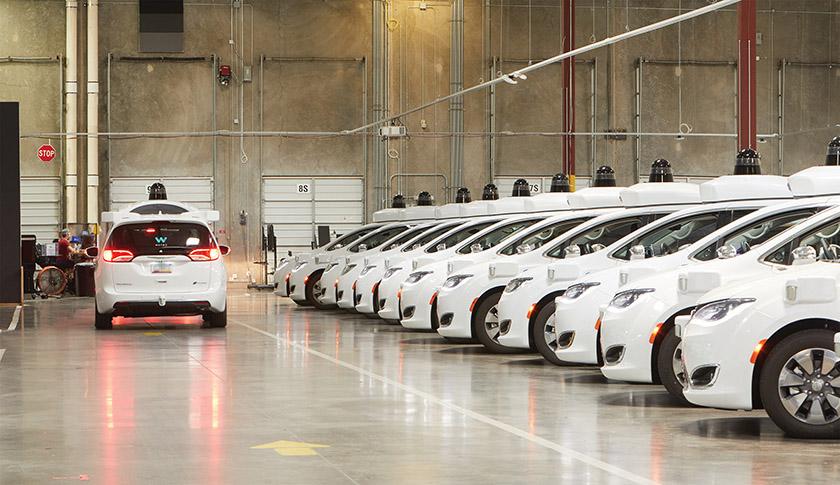
Refining Location
By Mark Lee Levine, CCIM, CRE, Ph.D., Libbi Levine Segev, JD, MS, LLM | Spring 2022
Location is a fundamental principle in the appraisal field. If a home was 25 feet from a beautiful ocean access point, many people, even those who aren’t real estate experts, would likely think its location makes it very valuable, simply because of its proximity to the water. Likewise, an office building in the heart of a popular business district might be valued more than the same building in a more remote area.
But does the importance of location remain static? Or is there a dynamic aspect to it, especially with changing environmental and economic issues? Of course, the impact of the location factor must change — and the repositioning of factors, both favorable and unfavorable, can influence it.

Alphabet-owned autonomous vehicle company Waymo announced in March that it started offering fully driverless car rides to its employees in San Francisco.
Two recent developments — COVID-19 and the advent of driverless vehicles — have changed how people fundamentally interact with commercial real estate.
Driverless Vehicles & Remote Work
Consider the impact of driverless vehicles (DVs). A DV would allow an individual to work during the daily commute, answering emails, taking calls, etc. Does such a situation allow a worker to live farther from a central work location without incurring a significant a time loss because of the DV? If so, this changes the importance of location. Similarly, DVs have the potential to increase safety and reduce costs. With these positives, would the value of proximity to a CBD office building be less of a concern?
Access to transportation that is convenient but does not detract from the use of the residence is a positive factor when examining location. Rapid transit that is accessible (but not too close to a property so as to detract from the location because of related traffic) might be considered a positive aspect for a property if it is utilized, while the congestion and noise pollution associated with buses and light rail can be a negative if they are not used. DVs are an important technology with great potential to impact the cost, safety, time, and convenience in assessing a particular asset’s location. If you are required to work in a specific office, the location of that office obviously impacts where you choose to live.
Will the widespread adoption of DVs prove to be a major instrument to enhance the value of residential sites further from the business district? If a worker can have the benefit of a suburban home, providing more room for children to play, etc., yet still maintain good access to the business district by using a DV, this may enhance the suburban site and possibly lower the value of the site closer to the business district. That is, if the DV allows the worker to commute to the business district, allowing the passive commuter to work while being driven to the business district, this can change the value of surrounding residences, both near and far.
DV technology won’t erase the importance of location. But, arguably, DVs will lessen it in some instances. Location could be tempered by DVs as much as residential living locations have been affected by access to buses, trains, or other transportation.
If an employee can work remotely, saving time and resources, and if the employee can access the meetings that were previously available only in person, the location of the employer is less important. And wouldn’t it follow that what was once a very valuable location for an office might now be less so? Both DVs and virtual access to work are two crucial factors that could alter our concept of location when it comes to commercial real estate. So how should we modify the valuation process for assets affected by these trends?
A driverless vehicle would allow an individual to work during the daily commute. Does such a situation allow a worker to live farther from a central work location without incurring as significant a time loss because of the DV?
In a 2019 Forbes article concerning driverless trucks (DTs), the point was raised that the value of some locations, used prior to the development of the technology, have been impacted by the DT. The article noted:
“The U.S. Department of Transportation announced last fall that it will not interfere with the advent of driverless truck usage, but many states and municipalities remain extremely concerned. Immediate push-back came from consumer rights groups concerned with safety and potential cyberthreats, and a significant public fear of autonomous vehicles. I believe if public fear manifests in delays and regulation, then even if the industry is ready to roll out these trucks in the next few years, they are probably many more years away from visiting your neighborhood streets. The logistics industry will be OK with that for now, while focus remains on driverless trucks for highway use only.
“Ultimately, driverless trucks may certainly impact facilities’ location decisions in a few important ways. Intuitively, we are inclined to think the technology will allow for fulfillment centers to be in more rural/lower-cost environments, which may be true, but only to the extent those environments can still provide enough labor for the facility to operate. Despite rapid advances in robotics, e-commerce warehouses are labor-intensive, so locations will require a solid labor pool to be available.”
Clearly, the automobile has allowed workers to live farther from the main office, even if working at a central office is required. Additionally, rapid transit and other means of convenient, safe, and cost-efficient transportation have increased flexibility for a worker’s location. The DV and virtual access, therefore, may provide even more advantages to some locations.
Given the developments since the onset of COVID-19 and the need and/or desire to work remotely, do such safety concerns encourage more individuals to work remotely — both in the short term and long term? Even when personal and public health concerns dissipate, will workers still want to work at home or at a distance from the office?
A lot of speculation has focused on just how transitory and how much of these changes will remain the standard employment approach in the field. Will Zoom or other platforms be the standard interface for many meetings? These and many related questions continue to be discussed as COVID-19 and new strains continue to impact private and public lives and businesses.
Have We Been Wrong About the Importance of Location?
One of the most fundamental axioms real estate investors, homeowners, brokers, attorneys, financial advisers, CPAs, developers, lenders, mortgage brokers, appraisers, insurance agents, and all others who find themselves involved with real estate is location, location, location.
But have we accepted this principle of location for so long that we do not question it? Should we question it? Was location always very important — even crucial — in years past, but not as much now in some settings?
Have we accepted this principle of location for so long that we do not question it? Should we question it? Was location always very important — even crucial — in years past, but not as much now in some settings?
If “location, location, location” was always foundational in determining where McDonald’s chose to open a new restaurant, is this still true? While customers primarily chose to walk into a McDonald’s previously, it appears things have changed. The impulse to eat a hamburger is still there, but the dominant principle of location has changed because McDonald’s now reports that the drive-thru and delivery options from its stores are the stronger percentage of sales. Is location less important if McDonald’s moves further toward taking more orders for delivery? Does this same issue apply to many businesses?
Today, unlike 40 years ago, walk-in sales do not constitute the majority of sales at many McDonald’s locations, as the trend towards drive-thru continues. Of course, this change does not change the import of location, location, location. But what if, hypothetically, a huge percentage of sales of a given McDonald’s — at least since COVID-19 — starts coming from delivery? How important is the location of the store now? With delivery, one might argue that McDonald’s does not need to be on the best corner on the best street. (Of course, location can still be a dominant factor for the store to provide the best spot for the kitchen to allow for the best delivery speed.)
Delivery has always been important for many fast-food companies, but it appears this trend will continue to grow. In one recent note, McDonald’s emphasized the importance of delivery.
- On a recent earnings call, McDonald’s CEO Stephen Easterbook said that delivery is the fast-food giant’s next “big frontier.”
- The company’s customers are placing 10 McDelivery orders every second worldwide, Easterbrook added.
- In 2019, McDonald’s delivery business is expected to generate $4 billion, or about 4 percent, of global sales.
- Some Wall Street analysts are echoing Easterbrook’s sentiment that delivery could be the next big growth opportunity for the company.
The delivery business should grow faster than previously forecasted with the use of DV.
As for location, what if the McDonald’s food is being cooked as a “kitchen on wheels” that moves to the destination where the food will be delivered? How important is the location of the store, where the kitchen picks up supplies, etc.?
This same discussion of location can be raised for Starbucks and other establishments that are moving toward more and more delivery of their products. This delivery approach raises the question of how the factor of location will be weighed in valuing property going forward.
There is no question that location impacts the income stream for most commercial properties. Thus, the factor of location remains important. But the entire concept of location — and the valuation of commercial real estate assets — will need to be rethought in light of the above changes.






